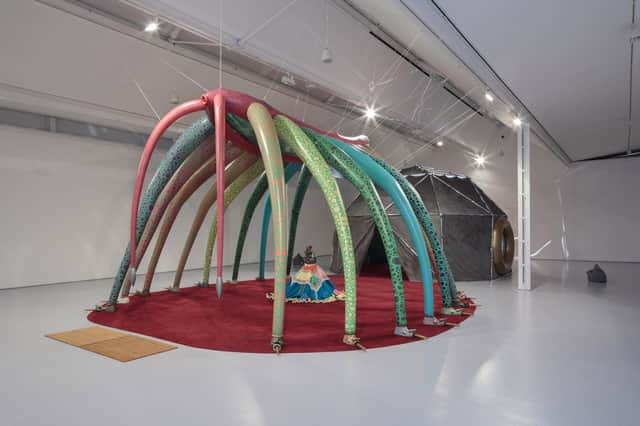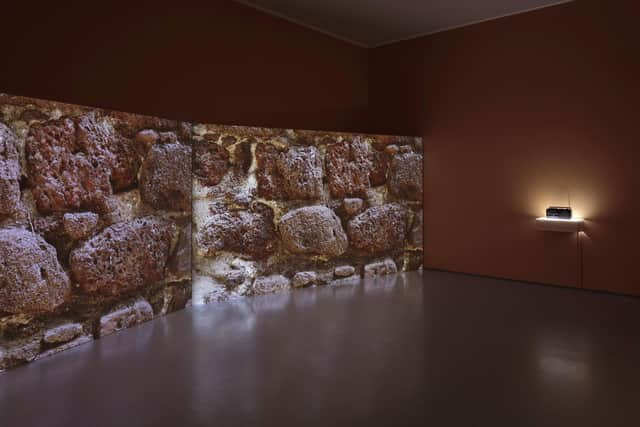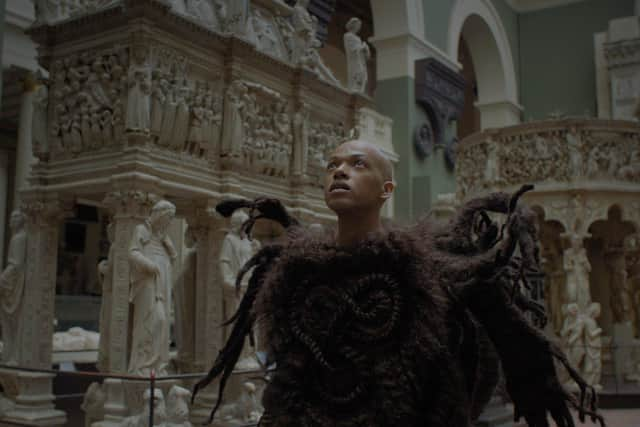Art reviews: Tako Taal | Rae-Yen Song | Amartey Golding


Tako Taal: At The Shore Everthing Touches, Dundee Contemporary Arts ***
Rae-Yen Song: ▷▥◉▻, Dundee Contemporary Arts ****
Amartey Golding: Bring Me To Heal, Tramway ****


Working out one’s own identity is often a process of negotiating with the past, whether that of one’s own family or a larger cultural history – this is grist to the mill for many artists, and is the fire burning under all of these shows, the biggest exhibitions to date for all three artists.
Advertisement
Hide AdGlasgow-based Tako Taal focusses her reflections on a specific place, Juffureh in the Gambia, her father’s home village, close to the British slave fort on what was once James Island, now renamed Kunta Kinteh Island after the protagonist in Alex Haley’s 1976 novel, Roots. The book and film now bring flocks of western tourists to the area.
This show was made over several years, while Taal went through the papers left by her father, Seedy Taal, who died in 1990.
The show includes some of her source material: a collage of family photographs and objects; typewritten manuscripts of her father’s poems; two images of the area created in 1987 by the Scottish artist Maud Sulter. There are also a handful of small (and accomplished) watercolours.


At its centre, however, is a 33-minute dual-screen film which combines some of these materials with words and footage from the Gambia, a fragmented, impressionistic exploration of landscape and memory. Images overlap and repeat, rather in the way that memories do, while Claude Nouk’s analogue soundtrack loops on a little cassette player.
It’s less about the area’s dark past, or its present as a tourist destination, as it is an internal exploration of her own feelings about Juffureh, and the similar sentiments she discovered in her father’s writing. It becomes a fragile, poignant, connection between them. As art, it’s thoughtful and evocative, but feels like it needs a little more confidence in its material, and its voice.
By contrast, there is nothing tentative about Rae-Yen Song’s work in the gallery next door. Song confidently takes on the larger space, using it to build a sculpture which is part temple, part body. It is literally an internal journey – viewers enter under the belly of the beast, propped up on its 14 spidery legs. Further in, under a tent-like structure, lie its organs and head. Video is projected on to various parts, and there is an immersive soundtrack which sounds very much like a body might sound on the inside.
Advertisement
Hide AdIt’s an impressive feat of making, using a broad range of materials, with superb attention to detail and a bright, bold aesthetic which is part kitsch, part mythology, like a eastern temple furnished by Jeff Koons. I don’t think I can tell you what it means: the ornate being clad in silk and fur which faces you when you walk in; the four-legged human-animal slowly spinning in the inner sanctum; the feet at the end of the 14 legs, each of which has several eyes.


The accompanying text will tell you that this is “an imagined dialogue with a long-departed grandfather”, another negotiation with the past, but one in which imagination and fantasy fill the gaps between the fragments. The title (in its own language of symbols) is pronounced “seoh”, which echoes the artist’s mother’s generation name and, in Hokkien dialect, loosely translates as “precious”.
Advertisement
Hide AdLike Taal’s work, it is in part about identity, but the conversation happens in a visual language for which no translation is provided. This much is private, perhaps. It might not be possible to see how the artist gets from A to B, but one can’t help but be impressed by the inventiveness of Song’s personal mythology, and its visual impact.
The idea of using a personal mythology to reframe the past is very much at the heart of Amartey Golding’s work for Tramway, Bring Me to Heal, which is the Brighton-based artist’s largest show to date. But his negotiation is not only with his own ancestors (he has an Anglo-Scots mother, a Ghanaian father and a Jamaican stepfather) but with a wider race heritage of oppression and trauma.
At the heart of the show is Golding’s contemporary fable about a goose whose fate becomes tangled up with a tyrannical horse which tramples its way around the world leaving a trail of destruction. Only when the horse has destroyed itself can the goose nurture it into a new way of seeing. It’s not hard to see this as an allegory of western capitalism.
The story is told by the artist in a film, sitting at a cracking camp fire, and the entire exhibition space is almost dark, leaving us primed from the outset for some kind of magic. As the story is told, hands around the fire weave a sculptural costume made from human hair, which is spot-lit in the space like a weird god.
The costume, which is worn in the films by Golding’s brother Solomon, a dancer, combines elements of Afro hairstyles with motifs from the body art of ancient Britons. In the second film, Solomon becomes the god – or the everyman – walking the halls of the V&A Museum in London, observing the inhumanity of history as evidenced in western art.
Golding is interested in the points at which the tide of trauma rolling out through the generations can turn – perhaps whether it can be turned – and the costumed figure can walk back out of the museum determined to bring about a better future. It’s idealistic, perhaps, and occasionally puzzling, but it proposes an ambitious way of reframing the past. Not that the perpetrators of injustice get away with it, but that they, too, need to become part of a wider healing process, for human beings and for the earth.
Advertisement
Hide AdTako Taal and Rae-Yen Song until 20 March; Amartey Golding until 6 March
A message from the Editor:
Thank you for reading this article. We're more reliant on your support than ever as the shift in consumer habits brought about by coronavirus impacts our advertisers.
If you haven't already, please consider supporting our trusted, fact-checked journalism by taking out a digital subscription at https://www.scotsman.com/subscriptions